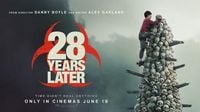Nearly three decades after the chilling outbreak that reshaped the world in Danny Boyle's 2002 classic 28 Days Later, the saga returns with 28 Years Later, a gripping new chapter set to hit theaters on June 20, 2025. This latest installment reunites the Academy Award-winning director Boyle with acclaimed writer Alex Garland, promising a fresh yet haunting exploration of survival in a world forever altered by the rage virus.
Boyle’s original film was a game-changer, not only redefining the zombie genre but also pioneering digital filmmaking techniques that influenced a generation of filmmakers. Yet, for years, the question lingered: what happens after the apocalypse? Boyle and Garland, who missed out on the 2007 sequel due to other commitments, kept the idea simmering until a 20th-anniversary screening of 28 Days Later in 2022 reignited their creative spark. “I was shocked. You could feel the audience's energy watching it,” Boyle recalled during a Business Insider interview, explaining how the packed theater convinced him and Garland there was still an appetite for the story. Garland then crafted the idea that would become 28 Years Later, focusing on a small island community that has survived in isolation for 28 years.
The film unfolds on Holy Island, off England’s northeast coast, where a group of about 150 survivors live disconnected from the mainland, which remains a dangerous, infected wasteland. The island is defended by bows and arrows, and access is controlled by a causeway that is exposed or submerged depending on the tides—an evocative symbol of the fragile boundary between safety and chaos.
Jodie Comer stars as Isla, a woman battling illness and ostracization within the tight-knit community, living with her husband Jamie, played by Aaron Taylor-Johnson. Their 12-year-old son Spike, portrayed by Alfie Williams, embodies a new generation that has no memory of the world before the virus. Spike’s first foray onto the mainland with a hunting party marks a pivotal moment, exposing him to mutated infected and survivors who have adapted in unsettling ways. Comer describes the film as “really quite surprising, within the genre but deeply moving and very intimate and sombre and tender in moments.”
The film’s narrative is steeped in themes of survival, family, and the passage of time. Boyle emphasizes that 28 Years Later is not a direct sequel but a singular story that draws from the original outbreak's legacy. The virus itself has evolved, with some infected learning to feed and organize, transforming into grotesque new forms—some fat and slithering, others towering titans—while others still collapse mid-rage. This evolution mirrors the relentless march of nature reclaiming the world, a motif reinforced by the film’s breathtaking locations in Northumberland, North Yorkshire, and Scotland, where dense forests and wild landscapes evoke a post-human Eden.
Boyle also acknowledges the influence of recent real-world events on the film’s tone and setting. The eerie emptiness of London streets during the initial COVID-19 lockdown echoed the desolation captured in the original movie, a parallel not lost on Comer, who noted how the pandemic made the film’s scenario feel uncannily familiar. Additionally, the isolationist sentiment following Brexit inspired the film’s depiction of a quarantined Britain turning inward, retreating to a nostalgic, almost medieval way of life.
Technologically, 28 Years Later pushes boundaries once again. Boyle and his team embraced iPhone cameras to capture lightweight, intimate footage in remote and fragile locations, marking one of the first uses of smartphone filming at a studio level. This approach allowed the crew to traverse untouched natural environments with minimal disruption, complementing the film’s raw, immersive aesthetic. Combined with drones and specialized night vision cameras, the cinematography promises a fresh visual experience that honors the original’s innovative spirit.
Adding to the film’s depth is the enigmatic “Bone Temple,” a massive ossuary constructed from 250,000 replica bones and 5,500 skulls, painstakingly built over six months. This haunting monument, created by the character Dr. Ian Kelson (Ralph Fiennes), serves as a somber reminder of mortality and memory, resonating with the film’s exploration of humanity amidst horror. Spike’s risky journey to visit Kelson with Isla underscores the film’s emotional core, highlighting themes of family, responsibility, and hope in a ravaged world.
The cast also includes Jack O'Connell and Ralph Fiennes, rounding out a talented ensemble that breathes life into this new chapter. Aaron Taylor-Johnson, who plays Jamie, praised Boyle’s vision and the franchise’s enduring legacy, acknowledging the challenge of living up to the original’s bar but expressing confidence in the creative team’s clear thematic direction.
Fans eager to celebrate the film’s release can look forward to a special Irish gala screening on June 20 at the Irish Film Institute in Dublin, where Danny Boyle himself will be in attendance. Sony Pictures is also supporting the launch with an impressive marketing campaign, including new posters for ScreenX, 4DX, and AMC theaters, the latter featuring a two-part giveaway series during opening night fan events.
Looking beyond 28 Years Later, Boyle is already involved in the sequel, 28 Years Later: The Bone Temple, directed by Nia DaCosta, known for her work on Candyman. Shot immediately after the current film, it continues the saga with some returning characters and new faces. Boyle is also poised to direct a third installment, which will finally bring back Cillian Murphy, the star of the original film, though financing remains pending. Boyle candidly admits that he used the promise of Murphy’s return to secure Sony’s greenlight for 28 Years Later, a strategic move that highlights the business realities behind big franchise filmmaking.
While Boyle’s career spans a diverse range of films—from the gritty social realism of Trainspotting to the Oscar-winning Slumdog Millionaire and the psychological thriller Sunshine—his work on the 28 Days Later franchise remains a defining legacy. Critics and fans alike have praised his ability to blend horror with social commentary, creating stories that are both thrilling and deeply human.
As the horror genre continues to grow in popularity, particularly among women audiences, Boyle reflects on its unique capacity to confront fears and offer creative freedom. 28 Years Later embodies this spirit, delivering a film that is as much about the fragility and resilience of family as it is about terrifying infected creatures and post-apocalyptic survival.
With its June 20 release just around the corner, 28 Years Later invites audiences to step back into a hauntingly transformed Britain, where hope, horror, and humanity collide in a story that is as intimate as it is epic.


